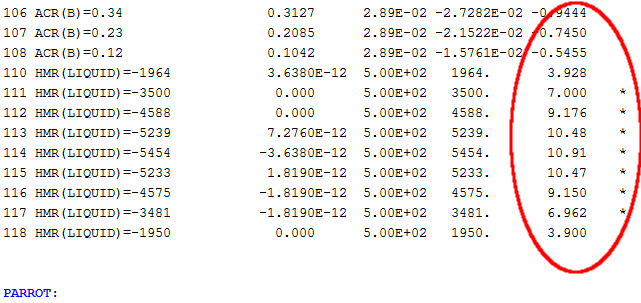Optimizing and Evaluating Results
When you have ensured that all the experimental data points can reach equilibrium, go back to the PARROT module and use OPTIMIZE_VARIABLES <number of iterations> with 0 iterations. Present the result of this initial optimization by using LIST_RESULT.
When evaluating the optimization results, the most important information is found in the list of experiments at the end of the listed results. The rightmost column shows the difference between the value of the experimental data and the value computed by Thermo‑Calc in the last optimization cycle.
The following shows part of list of experiments in the output of a LIST_RESULT command:
The experiments for which the optimization has not found a good fit are marked with an asterisk (*) or a hash sign (#) in the rightmost column. An asterisk in this column indicates that the experiment has an error that is larger than the error tolerance and a hash sign indicates that the error is much larger. The error tolerance depends on the degree of accuracy set for that particular piece of experimental information. The error values are presented in the next to rightmost column.
Note that if you are optimizing in alternate mode, then you usually do not need to change the weights for the experiments. Instead, you can simply run OPTIMIZE_VARIABLES again, specifying, say, thirty iterations, evaluate the results again, and continue in that way until you are satisfied with the results.
The Critical Set of Experiments
The set of weighted experiments that you end up with as a result of your optimization is referred to as the critical set of experiments. When you work to determine this set and the weights of the experiments, the following factors should be reflected in both the selection of experiments and the weights of those experiments:
- The reliability of the experimental technique.
- The extent of agreement/disagreement between independent measurements of the same quantity.
- The extent of agreement/disagreement between data obtained with different experimental methods.
